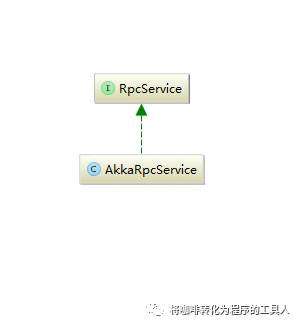最近,工具人突然被拉进了很多工作微信群。这些群有些共性:比如:
1,在这些群中,被动加入的都是工具人,而群主和他的朋友,都是工具的使用人;
2,在这些群中,工具的使用人各不相同,而工具就那么几个;
3,这些群,安静时是逢年过节,活跃时都在讨论用哪个工具人祭天;
4,这些群的名字,大部分都叫:XX需求爆肝群,XX问题背锅群,XX团队马屁群。
所以从被迫进群的那一刻,工具人们就如同开始了一场绝地求生的游戏,不约而同地开启消息免打扰,尽量保持隐身。于是,工具人很困惑,明明已经有开会这个消磨时间的沟通方式了,为啥还要在微信中打磨工具人呢?
在Flink中,同样让工具人困惑的是,之前学习了Flink的算子之间的数据传递过程,这部分的数据传递在Flink中是通过netty来实现的(相关阅读可以参见:「Flink」工具人之初学Flink-Task算子通信(一)和「Flink」工具人之初学Flink-Task算子通信(二)),而今天要学习的Flink组件之间的通信(如:JobMaster,TaskManager等)却是通过Akka来实现的。
在整个通信的设计的模型中,主要分为几个概念:
一,RpcService
RpcService的唯一实现就是AkkaRpcService,这就是组件事件通信的akka实体。

下图中,我们可以看到AkkaRpcService持有了进程的地址、服务端口,以及提供的一些核心服务。

在进程启动时,以JobManager为例:
ClusterEntrypoint.class
private void runCluster(Configuration configuration) throws Exception { synchronized (lock) { //各项服务初始化,其中就包涵了AkkaService的初始化 initializeServices(configuration); ..... } } protected void initializeServices(Configuration configuration) throws Exception { LOG.info("Initializing cluster services."); synchronized (lock) { final String bindAddress = configuration.getString(JobManagerOptions.ADDRESS); final String portRange = getRPCPortRange(configuration); //创建RpcService commOnRpcService= createRpcService(configuration, bindAddress, portRange); ...... }} @Nonnull private RpcService createRpcService(Configuration configuration, String bindAddress, String portRange) throws Exception { //创建了AkkaRpcService return AkkaRpcServiceUtils.createRpcService(bindAddress, portRange, configuration); }
二,RpcEndpoint是服务提供方,而RpcGateway是服务调用方的代理类。
如下面的类图中,我们以JobMaster举例:

JobMaster作为JobManager中的核心服务,他是服务提供方。由于他都受到了高可用的保护,会同时存在多个节点,所以,他都继承于FencedRpcEndpoint,并提供相应的RPC服务调用。
同时JobMaster也继承了JobMasterGateway,通过继承JobMasterGateway来约束了JobMaster必须提供的接口契约,JobMasterGateway是TaskManager中的JobMaster的代理实例,将会被TaskManager调用。
每个服务提供方(如:JobMaster)在初始化时,都会在基类RpcEndpoint的构造过程中,调用自动自己的Akka服务,创建ActorRef对象,绑定远端Gateway的动态代理,并返回了RpcServer对象。
RpcEndpoint.class
protected RpcEndpoint(final RpcService rpcService, final String endpointId) { this.rpcService = checkNotNull(rpcService, "rpcService"); this.endpointId = checkNotNull(endpointId, "endpointId"); //调用AkkaRpcService创建本服务的ActorRef,并绑定远端Gateway的动态代理 this.rpcServer = rpcService.startServer(this); this.mainThreadExecutor = new MainThreadExecutor(rpcServer, this::validateRunsInMainThread); }
这里我们截取部分rpcService::startServer的源码略作说明:
AkkaRpcService.class
@Override public checkNotNull(rpcEndpoint, "rpc endpoint"); ....... ActorRef actorRef; //在这里创建了actorRef synchronized (lock) { checkState(!stopped, "RpcService is stopped"); actorRef = actorSystem.actorOf(akkaRpcActorProps, rpcEndpoint.getEndpointId()); actors.put(actorRef, rpcEndpoint); } LOG.info("Starting RPC endpoint for {} at {} .", rpcEndpoint.getClass().getName(), actorRef.path()); final String akkaAddress = AkkaUtils.getAkkaURL(actorSystem, actorRef); final String hostname; Option if (host.isEmpty()) { hostname = "localhost"; } else { hostname = host.get(); } Set implementedRpcGateways.add(RpcServer.class); implementedRpcGateways.add(AkkaBasedEndpoint.class); final InvocationHandler akkaInvocationHandler; if (rpcEndpoint instanceof FencedRpcEndpoint) { // a FencedRpcEndpoint needs a FencedAkkaInvocationHandler akkaInvocatiOnHandler= new FencedAkkaInvocationHandler<>( akkaAddress, hostname, actorRef, configuration.getTimeout(), configuration.getMaximumFramesize(), terminationFuture, ((FencedRpcEndpoint) rpcEndpoint)::getFencingToken); implementedRpcGateways.add(FencedMainThreadExecutable.class); } else { akkaInvocatiOnHandler= new AkkaInvocationHandler( akkaAddress, hostname, actorRef, configuration.getTimeout(), configuration.getMaximumFramesize(), terminationFuture); } // Rather than using the System ClassLoader directly, we derive the ClassLoader // from this class . That works better in cases where Flink runs embedded and all Flink // code is loaded dynamically (for example from an OSGI bundle) through a custom ClassLoader ClassLoader classLoader = getClass().getClassLoader(); //在这里创建了动态代理 @SuppressWarnings("unchecked") RpcServer server = (RpcServer) Proxy.newProxyInstance( classLoader, implementedRpcGateways.toArray(new Class[implementedRpcGateways.size()]), akkaInvocationHandler); return server; }
而当JobMaster启动时,则会最终调用rpcServer的start方法
JobMaster.class
/** * Start the rpc service and begin to run the job. * * @param newJobMasterId The necessary fencing token to run the job * @return Future acknowledge if the job could be started. Otherwise the future contains an exception */ public CompletableFuture // make sure we receive RPC and async calls super.start(); return callAsyncWithoutFencing(() -> startJobExecution(newJobMasterId), RpcUtils.INF_TIMEOUT); }
这里的rpcEndpoint就是实际的ActorRef对象,向Actor发送了一个匿名的START指令,启动了endpoint。
RpcEndpoint.class
@Override public void start() { rpcEndpoint.tell(Processing.START, ActorRef.noSender()); }
三,连接过程
当TaskManager收到了ResourceManager的创建资源的消息后,会主动通知JobMaster,然后JobMaster会发起到TaskExecutor的连接。
JobLeaderService.class
/** * Retrying registration for the job manager <--> task manager connection. */ private static final class JobManagerRetryingRegistration extends RetryingRegistration<JobMasterId, JobMasterGateway, JMTMRegistrationSuccess> { private final String taskManagerRpcAddress; private final TaskManagerLocation taskManagerLocation; JobManagerRetryingRegistration( Logger log, RpcService rpcService, String targetName, Class String targetAddress, JobMasterId jobMasterId, RetryingRegistrationConfiguration retryingRegistrationConfiguration, String taskManagerRpcAddress, TaskManagerLocation taskManagerLocation) { super( log, rpcService, targetName, targetType, targetAddress, jobMasterId, retryingRegistrationConfiguration); this.taskManagerRpcAddress = taskManagerRpcAddress; this.taskManagerLocation = Preconditions.checkNotNull(taskManagerLocation); } @Override protected CompletableFuture JobMasterGateway gateway, JobMasterId jobMasterId, long timeoutMillis) throws Exception { //通知JobMaster,来连接TaskManager return gateway.registerTaskManager(taskManagerRpcAddress, taskManagerLocation, Time.milliseconds(timeoutMillis)); } }
这里其实就是通过动态代理AkkaInvocationHandler发起了远程调用。
在动态代理AkkaInvocationHandler内部,会根据调用的方判断是走本地调用还是远程调用。
@Override public Object invoke(Object proxy, Method method, Object[] args) throws Throwable { Class declaringClass = method.getDeclaringClass(); Object result; if (declaringClass.equals(AkkaBasedEndpoint.class) || declaringClass.equals(Object.class) || declaringClass.equals(RpcGateway.class) || declaringClass.equals(StartStoppable.class) || declaringClass.equals(MainThreadExecutable.class) || declaringClass.equals(RpcServer.class)) { result = method.invoke(this, args); } else if (declaringClass.equals(FencedRpcGateway.class)) { throw new UnsupportedOperationException("AkkaInvocationHandler does not support the call FencedRpcGateway#" + method.getName() + ". This indicates that you retrieved a FencedRpcGateway without specifying a " + "fencing token. Please use RpcService#connect(RpcService, F, Time) with F being the fencing token to " + "retrieve a properly FencedRpcGateway."); } else { result = invokeRpc(method, args); } return result; }
在Flink中,有些场景看起来像是发起了一个Rpc调用,其实调用的还是本地服务,比如:Standalone模式下向ResourceManager申请资源等。所以,invokeRpc中将所有的调用参数统一封装为一个叫RpcInvocation的数据结构。
它的两个子类LocalRpcInvocation和RemoteRpcInvocation 唯一的区别就是RemoteRpcInvocation 中的数据经过了序列化,方便网络传递。
protected RpcInvocation createRpcInvocationMessage( final String methodName, final Class[] parameterTypes, final Object[] args) throws IOException { final RpcInvocation rpcInvocation; if (isLocal) { rpcInvocation = new LocalRpcInvocation( methodName, parameterTypes, args); } else { try { RemoteRpcInvocation remoteRpcInvocation = new RemoteRpcInvocation( methodName, parameterTypes, args); if (remoteRpcInvocation.getSize() > maximumFramesize) { throw new IOException("The rpc invocation size exceeds the maximum akka framesize."); } else { rpcInvocation = remoteRpcInvocation; } } catch (IOException e) { LOG.warn("Could not create remote rpc invocation message. Failing rpc invocation because...", e); throw e; } } return rpcInvocation; }
收到请求后 JobMaster连接TaskExecutor,并返回TaskExecutorGateway
JobMaster.class
@Override public CompletableFuture final String taskManagerRpcAddress, final TaskManagerLocation taskManagerLocation, final Time timeout) { final ResourceID taskManagerId = taskManagerLocation.getResourceID(); if (registeredTaskManagers.containsKey(taskManagerId)) { final RegistrationResponse respOnse= new JMTMRegistrationSuccess(resourceId); return CompletableFuture.completedFuture(response); } else { // 连接TaskManager 并返回TaskExecutor return getRpcService() .connect(taskManagerRpcAddress, TaskExecutorGateway.class) .handleAsync( (TaskExecutorGateway taskExecutorGateway, Throwable throwable) -> { ...... }, getMainThreadExecutor()); } }
总结一下,以上整体过程大致如下图所示:

最后,工具人表示,在数不清的微信群中疲于奔命,会影响工作效率和质量;工具人们是喝咖啡集中精力思考与创造的工程师,而不是喝着麻辣烫,服务那个伺候这个的保姆。

 京公网安备 11010802041100号 | 京ICP备19059560号-4 | PHP1.CN 第一PHP社区 版权所有
京公网安备 11010802041100号 | 京ICP备19059560号-4 | PHP1.CN 第一PHP社区 版权所有